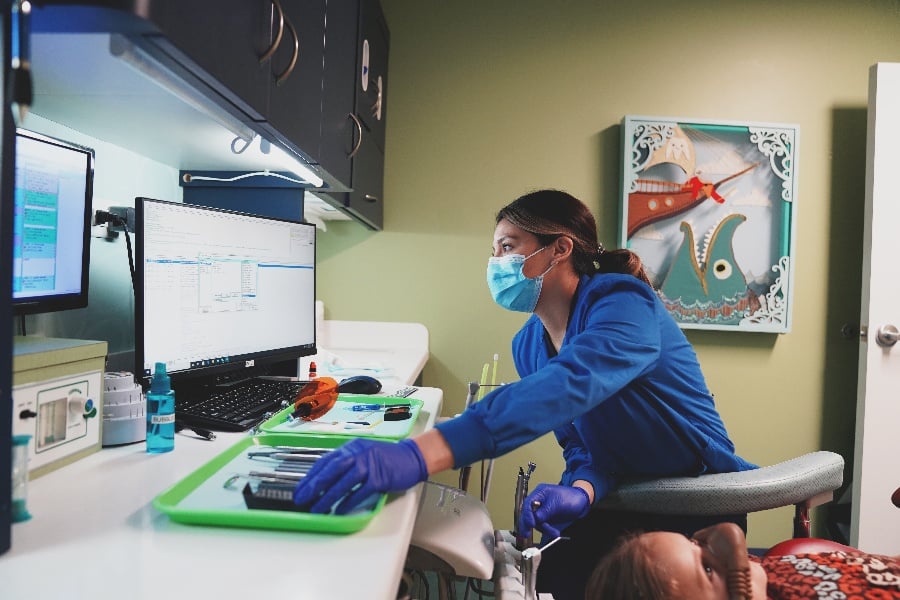CDT codes are essential for both billing and to document your dental care. Sure, you might already know that CDT stands for Current Dental Terminology. But you need a deeper explanation of how to use CDT codes in your practice.
After all, when you work in a dental office, you’ll be using CDT codes in your everyday life if you’re handling insurance claims.
Understanding dental terminology is important for accurate dental billing because it can affect your claim accuracy and cash flow. One of the challenges is keeping up-to-date when rules regarding those terms change constantly.
At Dental ClaimSupport, we always emphasize the importance of education among our remote billers. When dental teams outsource to us, we want them to feel confident that real dental billing experts are working to get their insurance claims reimbursed. And when it comes to dental billing education, CDT codes are a huge topic.
CDT codes can cause some confusion due to the complex nature of what it is and how it is used when filing a claim. It’s crucial to understand CDT codes and their purpose because they will affect the rate at which your claims are paid by insurance. Proper CDT coding will also ensure compliance that will prevent fraudulent claim submission.
In this article, we’ll explain what CDT is, what to do when it updates, and why it’s so important to understand CDT codes and document them properly.
So, what are CDT codes?
Current dental terminology (CDT) is a set of codes with descriptive terms developed and updated annually by the American Dental Association (ADA). Your team will need to follow these updates. We will include tips on keeping up with CDT changes later in this article.
The CDT Code is the official reference for terms that must be used in claims to third-party payers like insurance companies. So let’s break it down as basic as possible.
Each code begins with the letter “D” for Dentistry and is followed by four numbers. The 1st number will set the code range or service type. Think of it as labeling a dental procedure with a number.
Here is an example of a CDT code documentation for a protective restoration:
D2940 protective restoration
Direct placement of a restorative material to protect tooth and/or tissue form. This procedure may be used to relieve pain, promote healing, or prevent further deterioration. Not to be used for endodontic access closure, or as a base or liner under a restoration.
There are nine main service code type ranges that your dental team will need to understand, and there are about 20-30 common CDT codes that a typical practice uses daily. Memorizing the D0 to D9 ranges will make it easier to find a code.
Your dental team uses these codes to report the services your dentist has performed for patients. It’s a piece of the puzzle of properly documenting a procedure.
And documentation is key for timely claim reimbursement.
Using CDT codes on a dental insurance claim
You need to properly document CDT codes in order to receive reimbursement from insurance on a claim. Insurance denies claims that lack, or have inaccurate CDT coding attached. You can increase your dental practice’s cash flow when there is accurate CDT coding on a claim. This is why understanding CDT is crucial.
If you submit dental claims as either an in-network or out-of-network dental care provider, your work falls under the HIPAA guidelines - you have to use these codes.
They may already be present in your dental practice software, but you still need to know how to choose and use them correctly. And this is where understanding each code and the “why” behind CDT coding comes in handy.
The easiest way to find the CDT code for a procedure that is not commonly used is to determine the procedure type range code falls under and search that range in your practice management software. This is, of course only applicable if your practice management software has all of the CDT codes listed and updated within it.
Using the proper code will help you avoid delays in claim payment, but it will also create less confusion with the patient and insurance company.
Depending on your payment structure, (mostly applicable if yours is a fee-for-service practice) if your patient is awaiting reimbursement from insurance, and this payment is delayed due to inaccurate coding - you will likely have an annoyed patient.
But improper coding can be a common mistake if you aren’t staying up to date on CDT changes, so how can you keep up?
Keeping up with annual CDT changes to remain compliant
CDT codes are reviewed and updated annually due to technology and methods of procedures continuously changing. Not keeping up with these changes can lead to a few problems.
We mentioned above that you could face delays in claim reimbursement, but you could also be accidentally submitting illegitimate claims that can lead to insurance audits. Even if it’s simply a mistake - it doesn’t matter. You don’t want to get your dental practice into legal trouble.
CDT updates to look for every year would include the deletion of codes, editorial revisions, and new codes being added.
-1.jpg?width=660&name=DSC00906%20(1)-1.jpg)
You will need to make these updates in your practice management software manually.
For example, when the new CDT has a deleted code, the best way to handle it in your practice management software is to inactivate the code and follow your software program instructions on how to update your list of CDT codes. Do not delete the deleted codes.
If there is a new CDT code added, the best way to handle it is to add the code into your software and categorize it appropriately.
We recommend creating a CDT checklist when the annual updates roll out. We’ll share a few of our experts’ checklist items:
- Budget for your yearly updated CDT coding book
- Invest in a team (clinical and administrative) training on the CDT code changes affecting the practice
- Update the changes in the Practice Management Software
For a more detailed CDT changes checklist, enroll in our CDT course at Dental Claims Academy - you can even earn CE credit.
Build a productive, compliant billing process by investing in quality training
CDT codes can be a hard topic for dental teams to learn about. But receiving timely claim reimbursement and remaining compliant is worth the effort it takes to learn about CDT. It doesn’t have to be a huge, complicated mystery - you can choose to invest in your team billing education. This choice can lead to a healthier dental practice - financially, personally, and legally.
Dental Claims Academy is a great resource for dental teams to learn about CDT coding and other parts of the dental billing process. This knowledge can lead to more income for your dental practice, more confident employees, and more trusting patients.
Enroll in Dental Claims Academy by visiting our website.
Related Posts
Dental revenue resources from Dental Claim Support



